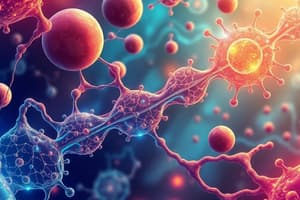Podcast
Questions and Answers
Which of the following best describes the relationship between catabolic and anabolic pathways?
Which of the following best describes the relationship between catabolic and anabolic pathways?
- Catabolic pathways synthesize complex molecules, while anabolic pathways break them down.
- Catabolic pathways release energy by breaking down complex molecules, while anabolic pathways consume energy to build complex molecules. (correct)
- Catabolic and anabolic pathways both release energy, but they act on different types of molecules.
- Catabolic and anabolic pathways both consume energy, but they operate in different cellular compartments.
Consider a chemical reaction with a positive $\Delta G$. Which statement best describes this reaction?
Consider a chemical reaction with a positive $\Delta G$. Which statement best describes this reaction?
- It will proceed spontaneously because the products have less energy than the reactants.
- It is an exergonic reaction that releases energy.
- It is an endergonic reaction that requires energy input. (correct)
- It is at equilibrium and does not require or release energy.
How does an enzyme catalyze a reaction?
How does an enzyme catalyze a reaction?
- By providing energy to drive an endergonic reaction.
- By altering the equilibrium constant of the reaction.
- By increasing the activation energy of the reaction.
- By lowering the activation energy of the reaction. (correct)
A scientist performs an experiment in which they increase the initial substrate concentration in the presence of a fixed amount of enzyme. What will happen to the rate of the reaction?
A scientist performs an experiment in which they increase the initial substrate concentration in the presence of a fixed amount of enzyme. What will happen to the rate of the reaction?
A drug binds to an enzyme at a location distinct from the active site, preventing the substrate from binding. This drug is acting as a(n):
A drug binds to an enzyme at a location distinct from the active site, preventing the substrate from binding. This drug is acting as a(n):
Which of the following best exemplifies the first law of thermodynamics in a biological system?
Which of the following best exemplifies the first law of thermodynamics in a biological system?
How does ATP hydrolysis drive endergonic reactions in the cell?
How does ATP hydrolysis drive endergonic reactions in the cell?
Which of the following statements is correct regarding the active site of an enzyme?
Which of the following statements is correct regarding the active site of an enzyme?
During cellular respiration, which process does not directly produce ATP?
During cellular respiration, which process does not directly produce ATP?
If a muscle cell lacks sufficient oxygen, which process will it primarily use to continue producing ATP, and what byproduct will accumulate?
If a muscle cell lacks sufficient oxygen, which process will it primarily use to continue producing ATP, and what byproduct will accumulate?
What is the primary role of NADH in ATP production during cellular respiration?
What is the primary role of NADH in ATP production during cellular respiration?
Which of the following correctly describes the movement of hydrogen ions (H+) in chemiosmosis?
Which of the following correctly describes the movement of hydrogen ions (H+) in chemiosmosis?
A cell is treated with a drug that inhibits the function of ATP synthase. Which of the following processes would be most directly affected?
A cell is treated with a drug that inhibits the function of ATP synthase. Which of the following processes would be most directly affected?
Unlike animals, plants are considered autotrophs. What does this mean in the context of energy acquisition?
Unlike animals, plants are considered autotrophs. What does this mean in the context of energy acquisition?
In photosynthesis, what is the role of chlorophyll?
In photosynthesis, what is the role of chlorophyll?
During the light-dependent reactions of photosynthesis, what is the primary outcome?
During the light-dependent reactions of photosynthesis, what is the primary outcome?
If a plant is exposed to green light only, what would be the likely impact on its photosynthetic activity?
If a plant is exposed to green light only, what would be the likely impact on its photosynthetic activity?
What happens to the ATP and NADPH produced during the light-dependent reactions?
What happens to the ATP and NADPH produced during the light-dependent reactions?
Flashcards
Energy
Energy
The capacity to do work or cause change.
Kinetic Energy
Kinetic Energy
Energy of motion.
Potential Energy
Potential Energy
Stored energy, ready to be used.
Chemical Energy
Chemical Energy
Signup and view all the flashcards
Exergonic Reactions
Exergonic Reactions
Signup and view all the flashcards
Endergonic Reactions
Endergonic Reactions
Signup and view all the flashcards
Enzyme
Enzyme
Signup and view all the flashcards
First Law of Thermodynamics
First Law of Thermodynamics
Signup and view all the flashcards
Cellular Respiration
Cellular Respiration
Signup and view all the flashcards
Aerobic
Aerobic
Signup and view all the flashcards
Anaerobic
Anaerobic
Signup and view all the flashcards
Glycolysis
Glycolysis
Signup and view all the flashcards
Oxidative Phosphorylation
Oxidative Phosphorylation
Signup and view all the flashcards
Fermentation
Fermentation
Signup and view all the flashcards
Autotroph
Autotroph
Signup and view all the flashcards
Heterotroph
Heterotroph
Signup and view all the flashcards
Stomata
Stomata
Signup and view all the flashcards
Stroma
Stroma
Signup and view all the flashcards
Study Notes
Energy and Metabolism
- Energy refers to the capacity to do work or bring about change.
- Kinetic energy involves energy of motion, like a moving car or flowing water.
- Potential energy describes stored energy due to position or structure, such as a stretched rubber band or a battery.
- Chemical energy represents a form of potential energy stored in chemical bonds, exemplified by glucose or ATP.
- Exergonic reactions release energy, such as cellular respiration.
- Endergonic reactions necessitate an input of energy, as seen in photosynthesis.
- Anabolic pathways construct molecules, such as protein synthesis.
- Catabolic pathways break down molecules, for example, digestion.
- Metabolism is the sum of all chemical reactions within an organism.
- Activation energy represents the energy needed to initiate a chemical reaction.
- An enzyme is a biological catalyst accelerating reactions through reduced activation energy.
- The substrate refers to the specific molecule on which an enzyme acts.
- The active site is the region on the enzyme where the substrate binds.
- The First Law of Thermodynamics states that energy is neither created nor destroyed, only transferred or transformed.
- According to the Second Law of Thermodynamics, every energy transfer escalates the entropy (disorder) of the universe.
- Exergonic reactions release energy, and the reactants possess more energy than the products.
- Endergonic reactions absorb energy, and the products contain more energy than the reactants.
- ATP hydrolysis (ATP breakdown into ADP + Pi) releases energy, powering endergonic reactions.
- Enzymes accelerate reactions by lowering activation energy and binding to substrates to facilitate reactions.
- During enzyme-substrate interaction, an enzyme binds to a substrate at the active site, thus forming an enzyme-substrate complex.
- A reaction occurs, converting the substrate into products, which are then released, enabling the enzyme to catalyze additional reactions.
- Competitive inhibitors bind to the active site and block the substrate.
- Non-competitive inhibitors bind to a different enzyme part, changing its shape.
Cellular Respiration
- Photosynthesis refers to the process where plants transform solar energy into chemical energy.
- Cellular respiration is the breakdown of glucose to produce ATP.
- Aerobic processes necessitate oxygen, such as cellular respiration.
- Anaerobic processes do not require oxygen, for instance, fermentation.
- The electron transport chain (ETC) comprises a protein series that transfers electrons to produce ATP.
- Glycolysis, the initial step of cellular respiration, breaks down glucose into pyruvate.
- The citric acid cycle (Krebs cycle), the second stage of cellular respiration, generates electron carriers.
- Oxidative phosphorylation involves ATP production using ETC energy.
- Chemiosmosis refers to the movement of H+ ions across a membrane to drive ATP synthesis.
- ATP synthase is an enzyme synthesizing ATP using H+ gradient energy.
- Fermentation refers to anaerobic ATP production when oxygen is unavailable.
- Cellular Respiration Formula:
- The human body uses energy for movement, metabolism, and homeostasis maintenance.
- NADH donates electrons to the ETC, creating an H+ gradient to generate ATP.
- Glycolysis occurs in the cytoplasm and breaks down glucose into pyruvate, marking the first stage of cellular respiration.
- The Citric Acid Cycle occurs in the mitochondria and produces electron carriers (NADH, FADH2).
- The ETC and oxidative phosphorylation occurs in the mitochondrial membrane and uses electron carriers to produce ATP.
- Glycolysis yields 2 ATP, 2 NADH, and 2 pyruvate molecules.
- Pyruvate transition yields 2 Acetyl-CoA, 2 NADH, and 2 CO2.
- The Citric Acid Cycle yields 2 ATP, 6 NADH, 2 FADH2, and 4 CO2.
- ATP synthase uses the H+ gradient created by the ETC to phosphorylate ADP into ATP.
- The ETC and oxidative phosphorylation generate the most ATP, about 34 ATP.
- Cells perform fermentation to regenerate NAD+ when oxygen is absent.
- Lactic Acid Fermentation produces lactate, which can be seen in muscle cells.
- Alcoholic Fermentation produces ethanol and CO2, commonly seen in yeast.
- Facultative anaerobes can survive with or without oxygen.
- Obligate anaerobes cannot survive in oxygen.
Photosynthesis
- Autotrophs are organisms that produce their own food, e.g., plants.
- Heterotrophs are organisms that consume others for energy, e.g., animals.
- Chlorophyll refers to the green pigment in plants that absorbs light energy.
- Stomata are small openings on leaves that facilitate gas exchange.
- The thylakoid refers to a membrane-bound compartment in chloroplasts where light reactions occur.
- The stroma is the fluid inside the chloroplast where the Calvin cycle occurs.
- A granum is a stack of thylakoids.
- A pigment refers to a molecule that absorbs light.
- The electromagnetic spectrum constitutes the range of all possible light wavelengths.
- Visible light is the portion of the spectrum plants use for photosynthesis.
- Light-dependent reactions use light to produce ATP and NADPH.
- Carbon fixation incorporates CO2 into organic molecules.
- A photosystem refers to a protein-pigment complex that captures light.
- The Calvin Cycle uses ATP and NADPH to synthesize glucose.
- Autotrophs produce their own food, while heterotrophs consume others for energy.
- Photosynthesis Equation:
- Light-Dependent Reactions convert light energy into ATP and NADPH in the thylakoid.
- The Calvin Cycle uses ATP and NADPH to synthesize glucose.
Studying That Suits You
Use AI to generate personalized quizzes and flashcards to suit your learning preferences.




